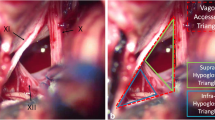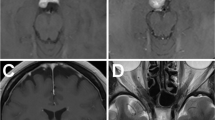Abstract
Approaches to the cerebellar-pontine angle and petroclival region can be challenging due to intervening eloquent neurovascular structures and cerebellar retraction required to view this anatomic compartment with the standard retrosigmoid technique. As previously described [11], the extended retrosigmoid provides additional access to space ventral to the brainstem through mobilization of the sigmoid sinus. We report our further experience and modifications of this approach for neoplastic pathology. The standard craniotomy is utilized, and the burr holes are placed slightly beyond the transverse sinus as well as the transverse–sigmoid junction and down towards the foramen magnum, as low as possible. Another burr hole is placed over the cerebral hemisphere to facilitate the dural dissection below the bone flap and over the transverse and sigmoid sinuses. We then perform a standard retrosigmoid craniotomy with a craniotome and the transverse and sigmoid sinuses are skeletonized. Consequently, the sigmoid sinus can then mobilized anteriorly to provide an unobstructed view in line with the petrous bone, while exposure of the transverse sinus provides access to the tentorium. Fifteen patients (March 2006–July 2008) underwent this approach to manage neoplastic lesions, including five meningiomas, three schwannomas, one epidermoid, and four intra-axial metastatic lesions. The nine extra-axial lesions were predominantly in the cerebellar-pontine angle with extension medial to the seventh/eighth nerve complex to the petroclival region. Gross total resection was obtained in all patients. The primary complication due to the exposure was a clinically asymptomatic sigmoid sinus thrombosis in one patient. Requiring a fundamental change in the management of the venous sinuses, the extended retrosigmoid craniotomy permits mobilization of the sigmoid and transverse sinuses. In this process, the entire cerebellar-pontine angle extending from the tentorium to the foramen magnum can be visualized with minimal cerebellar retraction. This technical modification over the standard retrosigmoid approach may provide a useful advantage to neurosurgeons dealing with these complex lesions.



Similar content being viewed by others
References
Al-Mefty O, Fox JL, Smith RR (1988) Petrosal approach for petroclival meningiomas. Neurosurgery 22:510–517
Al-Mefty O, Ayoubi S, Smith RR (1991) The petrosal approach: indications, technique, and results. Acta Neurochir Suppl (Wien) 53:166–170
Baldwin HZ, Miller CG, van Loveren HR et al (1994) The far lateral/combined supra- and infratentorial approach. A human cadaveric prosection model for routes of access to the petroclival region and ventral brain stem. J Neurosurg 81:60–68
Baldwin HZ, Spetzler RF, Wascher TM et al (1995) The far lateral-combined supra- and infratentorial approach: clinical experience. Acta Neurochir (Wien) 134:155–158
Cho CW, Al-Mefty O (2002) Combined petrosal approach to petroclival meningiomas. Neurosurgery 51:708–716, discussion 716–708
Day JD, Tschabitscher M (1998) Anatomic position of the asterion. Neurosurgery 42:198–199
Gharabaghi A, Rosahl SK, Feigl GC et al (2008) Surgical planning for retrosigmoid craniotomies improved by 3D computed tomography venography. Eur J Surg Oncol 34:227–231
Heros RC (1986) Lateral suboccipital approach for vertebral and vertebrobasilar artery lesions. J Neurosurg 64:559–562
Katsuta T, Rhoton AL Jr, Matsushima T (1997) The jugular foramen: microsurgical anatomy and operative approaches. Neurosurgery 41:149–201, discussion 201–142
Kawase T, Toya S, Shiobara R et al (1985) Transpetrosal approach for aneurysms of the lower basilar artery. J Neurosurg 63:857–861
Quinones-Hinojosa A, Chang EF, Lawton MT (2006) The extended retrosigmoid approach: an alternative to radical cranial base approaches for posterior fossa lesions. Neurosurgery 58:ONS-208–ONS-214, discussion ONS-214
Rhoton AL Jr (2000) The cerebellopontine angle and posterior fossa cranial nerves by the retrosigmoid approach. Neurosurgery 47:S93–S129
Rhoton AL Jr (2000) Jugular foramen. Neurosurgery 47:S267–S285
Sekhar LN, Kalia KK, Yonas H et al (1994) Cranial base approaches to intracranial aneurysms in the subarachnoid space. Neurosurgery 35:472–481, discussion 481–473
Shelton C, Alavi S, Li JC et al (1995) Modified retrosigmoid approach: use for selected acoustic tumor removal. Am J Otol 16:664–668
Silverstein H, Norrell H, Smouha E et al (1989) Combined retrolab-retrosigmoid vestibular neurectomy. An evolution in approach. Am J Otol 10:166–169
Silverstein H, Nichols ML, Rosenberg S et al (1995) Combined retrolabyrinthine-retrosigmoid approach for improved exposure of the posterior fossa without cerebellar retraction. Skull Base Surg 5:177–180
Spetzler RF, Daspit CP, Pappas CT (1992) The combined supra- and infratentorial approach for lesions of the petrous and clival regions: experience with 46 cases. J Neurosurg 76:588–599
Author information
Authors and Affiliations
Corresponding author
Additional information
Comments
Nader Sanai, Phoenix, USA
In this concise report, Dr. Quinones-Hinojosa and colleague review their experience with the extended retrosigmoid craniotomy for both intra- and extra-axial tumors of the posterior fossa. While this technique was originally described in the context of vascular skull-based lesions, its application to large posterior fossa masses is emblematic of an emerging trend in neurosurgical oncology adapting vascular surgery techniques for brain tumors. The study findings support the utility of this approach, demonstrating maximal resection with minimal morbidity.
Nicholas B. Levine, Raymond Sawaya, Houston, Texas, USA
Raza et al. describe a variant of the retrosigmoid technique, which includes tailoring the craniotomy to allow for more exposure of the transverse and sigmoid sinuses. In the authors’ hands, this provides better visualization by eliminating the boney overhang which may prevent retraction of the dura and sinuses, thereby limiting the operative corridor and requiring retraction of the cerebellum. The technique is promoted for both intra- and extra-axial neoplastic lesions. One patient developed sigmoid sinus thrombosis due to the increased exposure of the sinus. Although asymptomatic in this series, this can lead to pseudotumor cerebri and other neurologic sequelae. The authors mention that the petrous bone limits ventral access to the brain stem, a well-known anatomic limitation which has led to the use of posterior petrosectomies by skull base surgeons. The authors briefly discuss the limitations of petrous approaches. The extended retrosigmoid approach provides an alternative to formal skull base approaches.
Rights and permissions
About this article
Cite this article
Raza, S.M., Quinones-Hinojosa, A. The extended retrosigmoid approach for neoplastic lesions in the posterior fossa: technique modification. Neurosurg Rev 34, 123–129 (2011). https://doi.org/10.1007/s10143-010-0284-3
Received:
Revised:
Accepted:
Published:
Issue Date:
DOI: https://doi.org/10.1007/s10143-010-0284-3




